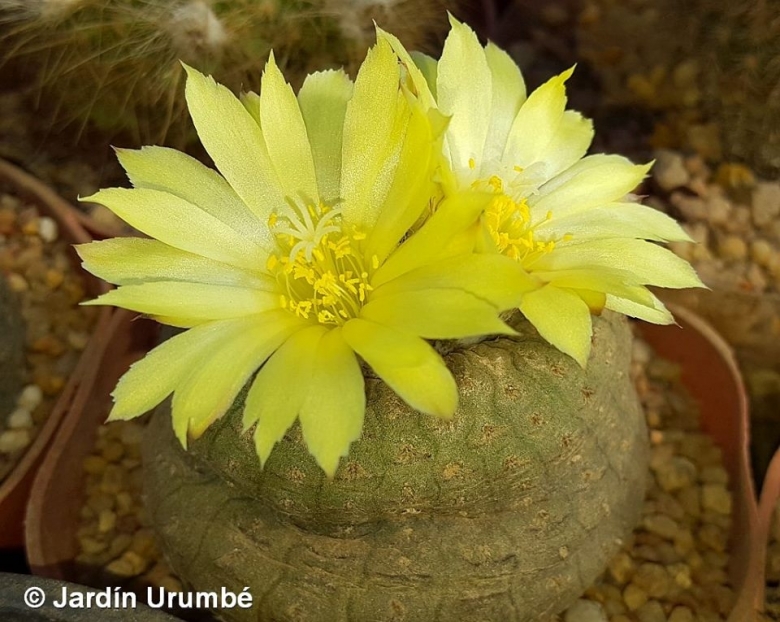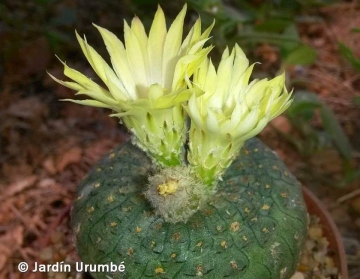
Frailea cataphracta subs. tuyensis Photo by: Alexander Arzberger
Origin and Habitat: Caapucú, Capilla Tuyá, and adjacent areas, Paraguarí, Paraguay
Altitude range: 120-300 metres above sea level.
Habitat and ecology: Frailea cataphractaSN|3597]]SN|3597]] var. tuyensis grows amongst grass and small bushes in partial shade.
Synonyms:
See all synonyms of Frailea cataphracta
back
Accepted name in llifle Database:Frailea cataphracta subs. tuyensis (Buining & G.Moser) P.J.Braun & EstevesSucculenta (Netherlands) 74: 130 1995.Synonymy: 5
Accepted name in llifle Database:Frailea cataphracta (Dams) Britton & RoseCactaceae (Britton & Rose) 3: 210. 1922 [12 Oct 1922]Synonymy: 3
Accepted name in llifle Database:Frailea cataphracta subs. duchii (G.Moser) P.J.Braun & EstevesSucculenta (Netherlands) 74: 130 1995Synonymy: 11
back
Description: Frailea cataphractaSN|3317]]SN|3597]] subs. tuyensis is regarded by most authors as a local or morphological form of the widespread and variable Frailea cataphractaSN|2188]]SN|3597]], while other authors consider this plant closer to Frailea pumilaSN|3597]]SN|2188]] (Frailea pygmaeaSN|3597]]SN|3317]] subs. tuyensis). It has fewer than 20(21) ribs, these are almost flat ash-green with dull-green dividing lines and black green moon-shaped markings under the areoles. The flowers are pale lemon yellow.
Derivation of specific name: This member of the Cactaceae family was given this name for the occurrence near Capilla Tuya, Paraguay.
Stem: Single, 30-35 mm tall, to 40 mm in diameter.
Ribs: Up to 20, very flat, ash-green separated by dull-green dividing lines, and black green to purple moon-shaped markings under the areoles to 5 mm wide.
Areoles: Oval, hairless or with little brown felt.
Spines: 4 on each side, pectinated, light brow, thickened and bulbous at the base, horn-colured to almost transparent above, up to 1 mm long.
Flowers Funnel-shaped, 24 mm long and 20 mm wide, bright-lemon yellow. Pericarpel 6 mm long, 5 mm wide, base bare, above with light brown bristles and white hairs. Receptacle 4 mm long, covered with yellow-brown bristles and white hairs. Outer perianth segments spatulate with fine bristly tips, white to dirty-yellow, with greenish-yellow strip at the bottom. Inner perianth segments spatulate, pointed, bright lemon yellow. Style 1 mm long, light yellow. Primary stamens 10 mm long erect, close to the style, light yellow. Secondary stamens 5 mm long, dull yellow. Anthers 0.8 mm long, yellowish-white. Nectar chamber 0.5 mm wide open. Seed cavity 3 mm long, 3.5 mm wide.
Fruit: Round, 8 mm in diameter, areoles with short light-brown bristles and white wool.
Seeds: Boat-shaped, 2 mm long and 1.6 mm wide, maroon, shiny. Testa, smooth with
netted drawing.
Subspecies, varieties, forms and cultivars of plants belonging to the Frailea cataphracta group
 Frailea cataphracta (Dams) Britton & Rose: (subsp. cataphracta), has dull green bodies with few (8-15) ribs, spine to 2 mm addpressed, centrals absent. Distribution: Bolivia and Paraguay.
Frailea cataphracta (Dams) Britton & Rose: (subsp. cataphracta), has dull green bodies with few (8-15) ribs, spine to 2 mm addpressed, centrals absent. Distribution: Bolivia and Paraguay. Frailea cataphracta subs. duchii (G.Moser) P.J.Braun & Esteves: has dirty bronze bodies with less than 18 ribs, spines to 4 mm, centrals absent or 1-2. Distribution: southeast of Asuncion, Paraguay.
Frailea cataphracta subs. duchii (G.Moser) P.J.Braun & Esteves: has dirty bronze bodies with less than 18 ribs, spines to 4 mm, centrals absent or 1-2. Distribution: southeast of Asuncion, Paraguay. Frailea cataphracta subs. melitae (Buining & Bredero) P.J.Braun & Esteves: (F. cataphracta subs. duchii) has less than 21 flattened, but noticeably tuberculate ribs. Distribution: Mato Grosso, Brazil
Frailea cataphracta subs. melitae (Buining & Bredero) P.J.Braun & Esteves: (F. cataphracta subs. duchii) has less than 21 flattened, but noticeably tuberculate ribs. Distribution: Mato Grosso, Brazil Frailea cataphracta subs. tuyensis (Buining & G.Moser) P.J.Braun & Esteves: has less than 20 ribs. Distribution: Paraguay.
Frailea cataphracta subs. tuyensis (Buining & G.Moser) P.J.Braun & Esteves: has less than 20 ribs. Distribution: Paraguay. Frailea cataphractoides Backeb.: (F. cataphracta subs. duchii) has greyish-olive-green bodies (purplish to black in full sun) with very closely set brown areoles and spines up to 4 mm long. Distributiin: Bolivia.
Frailea cataphractoides Backeb.: (F. cataphracta subs. duchii) has greyish-olive-green bodies (purplish to black in full sun) with very closely set brown areoles and spines up to 4 mm long. Distributiin: Bolivia. Frailea matoana Buining & Bredero: (F. cataphracta subs. duchii) has reddish to dark brown body with 15 ribs, areoles with brown or blackish spines to 4 mm long. Distribution: municípios de Antonio João, Mato Grosso do Sul, Brazil
Frailea matoana Buining & Bredero: (F. cataphracta subs. duchii) has reddish to dark brown body with 15 ribs, areoles with brown or blackish spines to 4 mm long. Distribution: municípios de Antonio João, Mato Grosso do Sul, Brazil Frailea uhligiana Backeb. in Backeb.: (F. cataphracta subs. duchii) has green to bronze bodies with up to 25 ribs and less adpressed spines up to 4 mm long. Distribution: San Jose between Santa Cruz and Corumba, Bolivia.
Frailea uhligiana Backeb. in Backeb.: (F. cataphracta subs. duchii) has green to bronze bodies with up to 25 ribs and less adpressed spines up to 4 mm long. Distribution: San Jose between Santa Cruz and Corumba, Bolivia.
Bibliography: Major references and further lectures
1) Urs Eggli, Leonard E. Newton “Etymological Dictionary of Succulent Plant Names” Springer Science & Business Media, 29 June 2013
2) K.H. Prestlé “Die Gattung Frailea (Br. & R.) Prestlé” third edition - 1998
3) Pierre J. Braun en Eddie Esteves Pereira. “Nieuwe combinaties en namen voor cactussen uit Brazilie, Bolivia en Paraguay.” Succulenta (Netherlands) 74 (3): 130-135, 1995.
4) Edward Anderson “The Cactus family” Timber Press, Incorporated, 2001
5) James Cullen, Sabina G. Knees, H. Suzanne Cubey “The European Garden Flora Flowering Plants: A Manual for the Identification of Plants Cultivated in Europe, Both Out-of-Doors and Under Glass” Cambridge University Press, 11 August 2011
 Frailea cataphracta subs. tuyensis Photo by: Alexander Arzberger
Frailea cataphracta subs. tuyensis Photo by: Alexander ArzbergerSend a photo of this plant.The gallery now contains thousands of pictures, however it is possible to do even more. We are, of course, seeking photos of species not yet shown in the gallery but not only that, we are also looking for better pictures than those already present.
Read More... Cultivation and Propagation: Frailea cataphractaSN|3597]]SN|3597]] subs. tuyensis is a summer grower species relatively easy to grow. It is sometime seen as a grafted plant but grows very well on its own roots too. Characteristically, during the dry season plants retract completely under the ground both in the wild and in cultivation too.
Growth rate: Fraileas are relatively short-lived plants, only lasting few years (rarely more than 10-15 years in cultivation) and, possible annuals in habitat! In fact they reseed readily around the base of the mother plant from self-set seed if kept reasonably moist during warm weather. It is a
good idea to keep restarting them from seed; what looks like a healthy big plant may suddenly die of old age without warning.
Soil: Use mineral well permeable substratum with little organic matter (peat, humus), plants may become too elongated if compost is too rich.
Repotting: Re-pot every 2 years. Use pot with good drainage.
Fertilization: It grows much faster with a low nitrogen content fertilizer in spring and summer. Potassium helps maintaining the plants compact and healthy.
Watering: Requires careful watering to keep plant compact. Water sparingly from March till October, the thin, fibrous roots suffer if there is humidity, therefore the plant should be watered only when the surrounding terrain is dry. Keep dry as soon as the temperature starts dropping in October and keep it perfectly dry in winter at temperatures from 5 to 15 degrees centigrade. High nocturnal humidity promote growth.
Hardiness: They need a minimum temperature of 5-10° C (but occasionally temperatures of a few degrees below 0° are not dangerous if kept on the dry side prior to, and during, cold weather). It tends to rot in winter during the resting phase, if kept wet. In the rest period no high atmospheric humidity!!
Sun Exposure: Light shade to full sun, its colour tends to richer and darker when grown in light shade. In a shaded position the plants grow faster, but are not flat shaped and dark coloured.
Propagation: With fresh harvested seeds or (rarely) by grafting. Fraileas set seed (when well grown) and grow easily from seed. In fact, they are reported to set seed even if the flower doesn’t open. This self-fertilization is called cleistogamy. Seedlings dislike strong light and dry conditions and need to be repotted frequently during the first few years. However, old plants become senile and have a tendency to succumb to disease and a weak root system. At this stage, as is well known, they die suddenly. So, after they reach about 4-5 cm in diameter grow them slowly, and adopt a new repotting period, using intervals of every 3-4 years. Additionally grow them under drier conditions or with stronger sunlight. But plants are sometine grafted to accelerate growth, but the grafted plants are typical rather tall growing, compared with plants on their own roots that are usually more flat to the ground.











